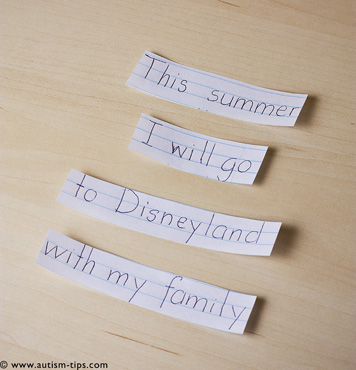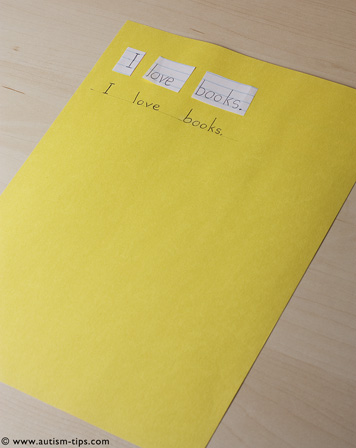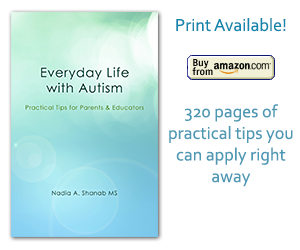A Quick Comprehension Test
Nadia Shanab | autism, general advice, parenting, tips2 Aug 2015
There is a way to go into children’s mind and see how they think (especially those with poor verbal skills) and check their understanding of the language. The activity explained below engages several senses along with the thinking process. The kids usually like it because it appears to them as a game. It includes cutting, arranging, pasting, and also copying. Besides, it is a great opportunity to put the fine motors (little muscles in the hands) to work. Additionally, eye-hand coordination too will get to practice. I like doing this activity in particular in the afternoon when the kids start to get tired and less interested in desk work. It helps make the last stretch of the day pleasant and relaxing.
Making Sentences
This is a hands-on activity that helps the child stay focused. It can be done at home or at school.
Supplies needed: paper, pencil, glue, ruler and scissors
- Write (or print out) level-appropriate sentences

- Cut out each sentence
- Cut out the words in each sentence
- Mix or scramble the words as puzzle pieces
- Ask the child to put the words together to make a valid sentence
- If she/he gets it right, mix the words again to be 100% sure that it was not by accident the child’s answer was correct, and ask the child to make the sentence one more time

- Have the child glue the words correctly arranged on the paper (I prefer thick paper or construction paper)
- If the words are not in the correct order ask the child to try again
- Keep trying until she/he gets it right (please encourage and recognize every achievement)
- Draw a line under the words and have the child copy the sentence on the line
- Finally, have the child read the sentence aloud
Rules of the game
- In the beginning choose short sentences of three or four words. Decide according to the student’s level.
- Remind the student that a sentence starts with a capital letter and ends with a period.
- When you feel that the child got used to the activity and comfortable with short sentences, move on to make longer sentences of five or six words.
- Keep this activity on the daily schedule and practice at least five sentences a day consistently.
- To expand the child’s skills using words and making sentences, write long sentences and cut out segments of the sentence instead of words. The segment can be two or three words long. By doing this you train the child to manipulate more words and more complex sentence structure.


- Keep all the work in one folder and name it “Making Sentences”. The child will be so proud when she/he looks at her/his work and gets the feeling of achievement.
You will be so surprised how special the children’s mind works. They can come up with very interesting sentence structure. Sometimes they can even come up with a different correct sentence.
You wouldn’t believe how much the students love this activity and I had to keep up with the pace and remember to prepare enough sentences for the following day. We had so much fun making sentences.
nadia shanab
Tags: asperger's syndrome, autism, communication, flexibility, language comprehension, occupational therapy, parenting, reading test, sensory, sensory integration issues, social interaction, speech, tips, visual aids



